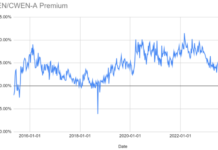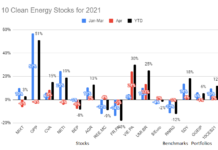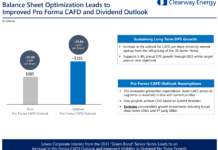Tom Konrad CFA
Clean energy yieldcos buck the general trend by paying out a large proportion of cash flow to investors, and rapidly increasing their dividends at the same time. The key to this trick has been their rapidly appreciating stock prices.
High yield companies generally grow slowly, while high growth companies have low dividend yields.
Normal companies grow by investing some profits in new business opportunities. Early stage growth companies typically retain all their earnings to invest in new business. More mature companies have fewer opportunities, and so share a larger proportion of profits with their shareholders. Mature companies tend to grow more slowly: they return more of their earnings to shareholders in the form of dividends, and the investments they do make tend to be less transformative and more incremental.
New investments can also be financed by selling more shares to the public. In this case, the company’s overall income will grow because it has more investments, but income per share can only increase if the new investments produce more income per share issued than the company’s existing investments.
The Strange Case of Yieldcos
Yieldcos are subsidiaries of clean energy project developers. They buy clean energy projects from their parent companies or other developers, and pay out nearly all of the income the projects produce as dividends to shareholders.
In finance jargon, the percentage of profits reinvested in the business is the “Retention Rate.” “Return on Investment” is a measure of how lucrative or transformative a business opportunity can be. Financial theory says that, if all new investments come from retained earnings, its growth rate will be the product of Retention Rate and Return on new investments.
By design, yieldcos’ retention rates are very low, yet all have been regularly increasing dividends, and most have targets for continuing to increase dividends per share at an extremely rapid rate.
According to the financial theory outlined above, yieldcos should only be able to accomplish this if their new investments are much more lucrative than their existing investments.
Skipping the math for clarity, the following chart looks at the three oldest yieldcos, chosen because they have more data available than other yieldcos. The three yieldcos shown are NRG Yield (NYSE:NYLD, NYLD-A), Pattern Energy Group (NASD: PEGI) and TransAlta Renewables (TSX:RNW, OTC:TRSWF).
The chart shows recent Retention Rates (amount of cash flow available for distribution which they do not pay out) in blue. It also shows recent dividend growth (red) and dividend growth targets (yellow and green.) The brown bars are return on investment from each company’s most recent publicly announced acquisition, while the light blue bars show what each yieldco’s calculated implied growth rate would be if the only source of growth were from investing retained earnings in the announced projects. The data is derived from company financial statements and press releases.
The Mystery
As you can see, the implied growth rates (1% to 2%) are far below actual and target dividend growth rates. This would normally lead us to the conclusion that yieldcos have extremely attractive opportunities for new investments. We would guess that money raised from the sale of shares to the public is invested these extremely attractive opportunities, and all shares would see a cash flow and dividend boost because the very high returns on new investments more than compensates for the dilution of the new shares.
As you can see in the following chart the returns on the yieldcos’ recent investments have been fairly low, and have not been rising significantly.

I show a rough measure return on investment for those acquisitions from the same three yieldcos where there was sufficient information disclosed for me to make the calculation. The measure shown is estimated annual cash flow divided by the equity invested. A more technically accurate measure would also take into account how annual cash flow changes over time, but that information is not available in the press releases.
As an aside, since these returns are based on estimates from company management, inter-company comparisons may not be meaningful. In particular, the fact that Pattern’s returns on investment have been higher than those of NRG Yield or TransAlta Renewables may be a product of different management assumptions, rather than a true economic advantage.
The mystery remains: Without retained earnings or great returns on investment, how are yieldcos raising their dividends?
The Weird Trick
Although yieldcos are not getting better returns on dollars invested, they are getting more money for the shares they sell.
For example, NRG Yield raised $11 per split adjusted share in its July 2013 IPO. In its July 2014 secondary offering, it sold shares at a split-adjusted $27 per share. Every dollar invested in the Energy Systems Company acquisition in 2013 produces 6.7¢ of annual cash flow. At $11 per share, that is 73¢ cash flow per share. In contrast, NRG Yield’s 2015 investment in the second group of Right of First Offer (ROFO) assets from its parent, NRG, produces a very similar 7.3¢ per dollar invested. But the shares it sold in July produce $1.97 of cash flow per share when invested in the ROFO assets.
While NRG Yield’s return on invested cash has barely budged since 2013, its return on each new share sold has grown almost three-fold.
The key to NRG Yield’s massive dividend per share growth is not better investment opportunities. The key to its dividend per share growth is selling stock to the public at ever increasing prices. Many other yeildcos are projecting per share dividend growth based on similar share price growth.
When Will It End?
As long as yieldcos can increase their invested capital per share by selling stock at higher prices, they should be able to continue increasing their per share dividends quickly. But given many yieldcos’ low current yields, the stock prices will only continue to rise as long as investors expect dividends to continue to grow rapidly.
So far, most yieldcos have enjoyed the benefits of a virtuous cycle of rising share prices and rising dividends. Rising share prices allow more cash flow per share sold, which in turn allows large dividend increases. Large dividend increases excite investors, who drive up stock prices, and the cycle repeats.
To keep the cycle going, yieldcos are on a treadmill which requires them to make ever larger purchases of new assets. This growing demand for renewable energy assets, will raise the prices of such assets and lead to declining returns on investment. This, in turn, is undermines future dividend growth, which in turn will undermine stock price growt
h.
At some point, the virtuous cycle will turn vicious. Failure to meet dividend growth expectations may lead to declining share prices, and lead to further declines in dividend growth, and so on. Or flat stock prices may make increases in cash flow per share harder to achieve, and this will lead to low dividend growth rates, leading investors to sell the stock.
What Can Investors Do?
Yieldco investors who wish to avoid getting caught in this vicious cycle should focus on those yeildcos with prices that are based more on current dividends than on future dividend growth. These are easy to identify: they are the yeildcos with the highest current yields.
TransAlta Renewables (TSX:RNW, OTC:TRSWF) currently tops the list, with a 6.6% yield at the current (Canadian dollar) share price of C$12.68 and 7¢ Canadian monthly dividend. It also has the advantage of slightly higher retained earnings than the other yieldcos, which should allow it to produce a little more conventional dividend growth than the others.
Note: The author of this article will be an instructor at EUCI’s “The Rise of The Yieldco” workshop on July 30th and 31st.
Disclosure: Long PEGI, TSX:RNW. Short NYLD, NYLD-A
DISCLAIMER: Past performance is not a guarantee or a reliable indicator of future results. This article contains the current opinions of the author and such opinions are subject to change without notice. This article has been distributed for informational purposes only. Forecasts, estimates, and certain information contained herein should not be considered as investment advice or a recommendation of any particular security, strategy or investment product. Information contained herein has been obtained from sources believed to be reliable, but not guaranteed.










How is this different from the REIT model? REITs pass through most of their earnings and issue equity to support acquisitions to support dividend growth. Strength in the share price allows them to do this more effectively. The concept sounds a little precarious but the model has produced blue chip dividend growers in real estate.
Good question, wish I’d answered it in the article.
The difference is the magnitude of dividend growth rates. Those REITs are not raising their dividends so quickly. I googled “best dividend growing REITs” and here is how much thier dividends have grown:
GOV – flat since 2012, less than 2% /year since Dec 2009, down since Oct 2009.
SNH – flat since 2012, up less than 2% / year since 2009.
HPT – up 2% over LTM, up less than 2%/year since 2009.
Where are the 10%-20% annual dividend growth rates? Most yieldcos have raised their dividends more in the last year than these REITs have raised theirs since 2009.
It looks like your Google search turned up high yielding REITs, but low growers. Some well known dividend growth REITs with a balanced yield/growth profile have 5 year DGRs in the high single digits.
O: 5.8%
ESS: 7%
OHI: 10%
VTR: 8%
These are probably the best comparisons to yieldcos because they have long term leases with low escalators. Yieldcos have long term PPAs with low escalators; I believe PEGI has 18 years weighted average remaining with something like a 1% escalator.
There are a few REITs with very rapid DGR and short lease durations, such as in the self storage industry, that are not good comparisons.
So high single digit DGR through equity issuance and acquisitions looks like a proven model, but as you point out the yieldcos are projecting (and achieving) high double digit DGR. TERP is even projecting 20%-24% dividend growth for the next 5 years through ROFO acquisitions.
Maybe the answer to the high growth rate lies in depreciation. This is just an idea, but REITs and Yieldcos both pay out a high proportion of their dividends as return of capital from depreciation, which distorts their P/E and payout ratios. Maybe if REITs are amortizing their assets over 40 years and Yieldcos are amortizing them over 20 or 30 years, they can pay out return of capital on a more aggressive schedule?
This brings up another point to consider, which is whether a renewable energy asset has a useful life beyond the PPA term, and whether it can be re-contracted for the same price or perhaps even a higher price per kWh, or whether the value of the asset actually goes to zero.
Thanks for the better comparables.
Regarding depreciation and if PPAs can be renewed, there’s an easy way to decide if this is part of the story. The 7-10% returns on investment I calculate in the article are CAFD/equity invested. If we can get similar annual FFO/equity invested numbers for your 4 examples, we’ll know it’s depreciation if the FFO Returns are lower than the CAFD returns.
According to this article http://www.forbes.com/sites/bradthomas/2015/04/22/understanding-cap-rates-the-answer-is-nine/, the equivalent number for REITs is the “Capitalization rate”, and REIT cap rates range from 6% to 10%, with OHI at the top end of this range. So yieldco cap rates are 1-2% higher than REIT cap rates… still not enough to account for the 10%+ difference in DGRs.